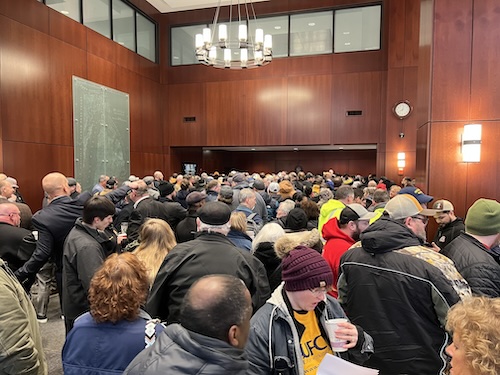Unions and working families in Michigan celebrated Feb. 13 as the state’s repeal of its so-called right-to-work law went into effect.

|
| Union members inside the Michigan House chambers just before legislators gathered to vote to repeal the state’s right-to-work law.
|

|
| Union members and their allies rallying in the Michigan statehouse last year, urging the legislature to repeal the state’s right-to-work law – which they did.
|
The Michigan General Assembly voted to repeal and Gov. Gretchen Whitmer signed the bill in March 2023. Michigan law states that any legislation passed and signed by the governor goes into effect 90 days after that legislative session ends.
That turned out to be Feb. 13. Michigan was the first state in nearly 60 years to repeal such a law, which weakens unions by allowing workers to reap the benefits of a collectively bargained contract without contributing to the cost of its negotiation and enforcement.
“Killing Michigan’s right-to-work law was a highlight of a terrific year for the IBEW and all of labor,” International President Kenneth W. Cooper said. “Working people in Michigan today are better protected on the job and empowered to negotiate even better pay and benefits because right-to-work is gone.”
The move was possible after Democrats took control of the Michigan House, Senate and governor’s office for the first time since 1984 in the November 2022 election. Whitmer and many Democratic legislators campaigned in part on repealing right-to-work if given the opportunity, and IBEW members joined with their allies to help get them elected. Whitmer was reelected by more than 10 points.
The Republicans passed a right-to-work law without public hearings and during a lame-duck session in 2012, when they controlled the Legislature and the governor’s mansion.
“I promised when this repeal was signed, we are not stopping with Michigan,” Cooper said. “The public is with us on this issue, including voters who are not union members. Many of them want the benefit of representation.”
There remain 27 states with full right-to-work laws on the books. Another potential target for repeal could be Wisconsin, which passed its version of the law in 2015. That was due in part to legislative districts in the state being drawn to overwhelmingly favor Republicans by the GOP-controlled legislature and governor, even though the number of registered Democrats and Republicans in the state is nearly equal.
Wisconsin is going through the redistricting process again. But this time, the governor is a close friend of labor and the state Supreme Court, which likely will hear any lawsuit to the process, has a 4-3 Democratic majority.
Those legislative districts and boundaries are crucial, as Michigan showed. In 2018, Michigan voters approved a ballot initiative that turned over the redistricting process to an independent commission. That led to districts that better represented the state’s political makeup and gave pro-working families candidates a fairer chance of being elected.